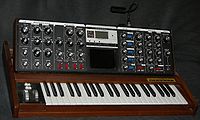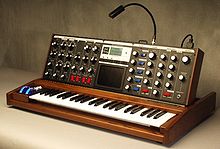- Minimoog Voyager
-
Minimoog Voyager Manufactured by Moog Music Dates 2002 - present Price US$2995 - US$3495 Technical specifications Polyphony Monophonic Timbrality Monotimbral Oscillator 3 VCOs, white/pink noise LFO independent LFO Synthesis type Analog Subtractive Filter dual lowpass or highpass/lowpass
with cutoff, resonance, spacing
ADSR envelope generator,
keyboard trackingAttenuator ADSR envelope generator Aftertouch yes Velocity sensitive yes Memory 128 presets
expandable to 896Effects 2 modulation busses Input/output Keyboard 44-note with velocity
and aftertouch sensitivityLeft-hand control pitch bend and mod wheels External control MIDI, 14 CV/Gate inputs The Minimoog Voyager or Voyager is a monophonic analog synthesizer, designed by Robert Moog and released in 2002 by Moog Music. The Voyager was modeled after the classic Minimoog synthesizer that was popular in the 1970s, and is meant to be a successor to that instrument.
Contents
Design
Like the original Minimoog, the Voyager has six sound sources. Five of these (three voltage-controlled oscillators with switchable waveforms, a noise generator, and an external line input) pass to a mixer with independent level controls. The mixed output of the sources is then passed through the voltage-controlled filter and a voltage-controlled amplifier, each of which has its own ADSR envelope generator. The voltage-controlled filter can itself be made to oscillate, thus comprising the Voyager's sixth sound source.
In addition to similar features of the original Minimoog, the Voyager was designed to have a memory bank capable of storing 128 presets, a touch pad modulation control, dedicated LFO, two modulation busses (one controllable via the modulation wheel and the other with a foot pedal), two ADSR envelopes for filter and amplifier control, a pressure-sensitive keyboard, 14 voltage-control inputs, and MIDI input/output.
Unlike the original Minimoog, the Voyager's modulation busses can be set to affect almost any parameter of the sound, not just the filters. Although the synthesizer features MIDI control and advanced patch storage, all audio paths in the Voyager are analog with the sound originating from any of three oscillators designed for high tuning stability, as the original Minimoog oscillators tended to slightly shift out of tune while playing.
With the Voyager, certain parameters that were fixed on the original Minimoog can be programmed to suit the player's preference. This includes selection between low-note, high-note or last-note priority. Also, the envelope generators can be set to retrigger with each pressed note or they can be set not to retrigger until all notes are lifted and the next note is played.
History
In November 2001, Moog Music (then Big Briar) announced that they planned to release an updated version of the Minimoog. The new synthesizer promised to have modern features, yet continue to be authentic to the original sound quality. The company offered a new synthesizer to the customer who could come up with a name for the project. Early in 2002, they announced that the synthesizer would be named the "Minimoog Voyager".
Late in the summer of 2002, Moog Music began shipping the new Voyagers. Occasionally a new system software release is made available, which can be downloaded from Moog Music's website and sent to the Voyager via MIDI. Recent software versions allow complex internal patching of control voltages, a very powerful and convenient feature for the user. Also available is the VX-351 Voyager Expander, an external box that is wired to the Voyager featuring 25 control-voltage outputs for physical CV patching. [1]
Recent versions of the Voyager software expand the original 128-patch memory to 896 patches by implementing seven selectable banks, A to G, with 128 patches each. The current model (2007) has most of the patches pre-programmed in groups corresponding to earlier software releases.
Models
The first 600 units could be preordered at the price of US$3495 and featured Bob Moog's personal autograph. The standard edition continues to sell for US$2995. Apart from the signature and price, the models are identical. Wood finish on the models is offered in walnut, cherry or maple.
For 2004, Moog Music released a limited 50th Anniversary Edition Voyager (AE). The wood cabinet was painted black and the control panel was backlit using electroluminescent technology. 2005 marked the end of production of these units, however Moog Music continues to sell a backlit model called the Electric Blue that features an iridescent blue cabinet finish. Both of these models have the same sound features of the non-backlit models but sell for US$3295. They now offer a customizable version of the Electric Blue named the Select Series, in which the customer can choose between mahogany, electric blue, traditional ash, white wash, maple, black, cherry, and walnut cabinets with red, blue, white, orange, green, or purple backlighting. Their retail price is the same as that of the Electric Blue model. [2]
In 2005, Moog Music released the Voyager Rack Mount Edition (RME), a synthesizer based on the Voyager. The RME was designed to occupy 5 spaces in a 19-inch rack. The model has all of the features of other Voyagers but does not include a touch panel control and is sold without a keyboard. The RME is designed to be controlled via MIDI. Up to 16 RME Voyagers can be combined to achieve polyphony.
In April, 2008, Moog Music released the Minimoog Voyager Old School (Voyager OS). The Voyager OS has enhanced modulation busses, which are just modulation busses with more sources on the panel to compensate for the lack of software and an operating system. The Voyager OS also does not have a touch pad or MIDI inputs and outputs. Unlike other Voyagers, it features a keyboard pitch CV out and keyboard gate CV out, without the aid of the VX-351. The Voyager OS's pitch bender is set to +/- 7 semitones, and can be modified by an internal jumper. The OS is sold with only one wood panelling option, "traditional ash". However, a few limited edition models were housed in white wash cabinets. As of January 15, 2009, the Voyager Old School has been discontinued. [3]
In late 2010, for the 40th anniversary of the Minimoog Model D, Moog Music released the Minimoog Voyager XL model. It is an expanded Voyager that includes, in addition to the original Voyager features, a larger 61-note keyboard, a ribbon controller, an additional LFO/modulation bus, and most notably, an analog patch bay on the far left of the instrument—providing a similar modular functionality to the VX-series products. [4]
Links to Artists/Albums/Songs featuring Voyager
- The Truth In Me solo album by Roger O'Donnell... realized exclusively with Minimoog Voyager.
- End Of The World... The Cure song featuring Minimoog Voyager solo in bridge section.
- All Moog Space Exploration with Jordan Rudess of Dream Theater. Periodic live streaming web jams featuring Vintage MiniMoog, a modern Minimoog Voyager, Arturia Moog Modular V software, and a Moog Etherwave Theremin.
- Jimmy LaValle of The Album Leaf uses the Minimoog Voyager as well as many other Moog synthesizers. The Minimoog Voyager can be heard primarily on his track "Wherever I Go" from his latest release "Into the Blue Again" on Sub Pop records.
- David Scott Stone has used the Minimoog Voyager quite a bit with The Melvins on tracks from Pigs Of The Roman Empire as well as with Big Business on their track "Another Beautiful Day in the Pacific Northwest".
- Incubus's Chris Kilmore uses the Voyager in the band's sixth album Light Grenades.
- Andy Tillison of progressive rock group The Tangent has utilised the Minimoog Voyager on all of the band's albums and live on tour.
- Patch #127 in the Minimoog Voyager "Bass for E. Vonallen" named after Synthpop/Industrial artist Ehron VonAllen. Sound is featured as the notable melody in VonAllen's song "Die For Me" from the album Your Only Friend.
- Todd Marriott of British synth-pop duo I Was A Cub Scout uses a Minimoog Voyager, among other synths, controlled from a series of MIDI-synced Korg Electribe sequencers.
- Daft Punk use four Minimoog Voyager Rack Mount Editions in their live tour-2 divided between Thomas Bangalter and Guy-Manuel de Homem-Christo.
- Franz Ferdinand use the Voyager in their live shows as well as on their latest album Tonight: Franz Ferdinand, most notably on the track "Lucid Dreams"
- Manfred Mann uses Minimoog Voyager , controlled from external MIDI keyboard on tours with the last reincarnation of Manfred Mann's Earth Band
- Rick Wakeman uses two Voyagers on Yes live tours
- Don Airey used the Voyager on the last Deep Purple tours
- Jordan Rudess used the Voyager near the end of the Dream Theater song "In The Presence Of Enemies, Pt. 2".
- Luca Anzilotti of Snap!
- Liam Howlett of The Prodigy uses a Voyager on live tours.
- Morgan Page, a world famous DJ and producer, can be seen using the MiniMoog Voyager in his music video "The Longest Road"
- Covenant use a Minimoog Voyager Performer Edition since the instrument first became commercially available.
- J Dilla used the Moog voyager
- Radiohead used the Voyager on their song Lotus flower as a polyphonic instrument[5][6].
References
- ^ "Voyager by Bob Moog - Analogue Performance Monosynth". Sound On Sound (June 2003). http://www.soundonsound.com/sos/jun03/articles/moogvoyager.asp.
- ^ "Voyager by Bob Moog - Version 2 OS Updates • Anniversary Edition • VX351 • CP251". Sound On Sound (November 2004). http://www.soundonsound.com/sos/nov04/articles/moogupdate.htm.
- ^ "Moog Voyager Old School". Sound On Sound (December 2008). http://www.soundonsound.com/sos/dec08/articles/moogvoyageroldschool.htm.
- ^ "Minimoog Voyager XL announced - Moog give you a semi". Sound On Sound. 2010-09-28. http://www.soundonsound.com/news?NewsID=13230.
- ^ https://twitter.com/#!/C418/status/118325010627694593
- ^ https://twitter.com/#!/C418/status/118341431457890304
External links
Categories:- Moog synthesizers
Wikimedia Foundation. 2010.





